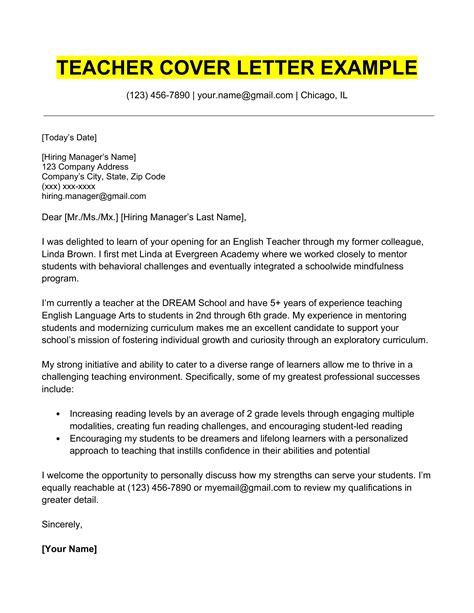Teacher Application: Tailoring Your Resume and Cover Letter
Landing your dream teaching position requires more than just a great teaching philosophy; it demands a compelling resume and cover letter specifically tailored to each application. Generic applications rarely cut it. This article will guide you through the process of crafting targeted materials that highlight your unique skills and experiences, making you a standout candidate.
What Makes a Teacher Resume Stand Out?
Your resume is your first impression. It needs to be concise, visually appealing, and packed with relevant keywords that Applicant Tracking Systems (ATS) scan for. Here's how to optimize yours:
1. Keyword Optimization: Before you even start writing, research the job description thoroughly. Identify keywords related to the subject matter, grade level, specific skills (e.g., differentiated instruction, technology integration, special education experience), and school culture. Incorporate these keywords naturally throughout your resume.
2. Reverse Chronological Order: List your experience starting with your most recent role. Use action verbs to describe your accomplishments, quantifying them whenever possible (e.g., "Increased student test scores by 15%," "Mentored 5 student teachers," "Developed and implemented a new curriculum for 100 students").
3. Highlight Relevant Skills: Don't just list your skills; show how you've used them. For example, instead of simply stating "Proficient in Microsoft Office," write "Utilized Microsoft Office Suite to create engaging lesson plans, track student progress, and communicate with parents."
4. Tailor to Each Application: This is crucial. Don't send the same resume for every job. Customize each one to match the specific requirements and keywords of the job description.
Crafting a Compelling Cover Letter
The cover letter is your opportunity to showcase your personality and passion. It should go beyond simply summarizing your resume; it should demonstrate your understanding of the school and its needs, and why you're the perfect fit.
1. Address the Specific School and Hiring Manager: Generic greetings are a turn-off. Research the school's mission, values, and recent initiatives. Address your letter to the specific hiring manager if possible, showing you've taken the time to personalize your application.
2. Showcase Your Understanding of the School's Needs: Refer to specific aspects of the job description and the school's website. Explain how your skills and experience align with their needs and goals. Demonstrate that you've done your homework.
3. Tell a Story: Don't just list your accomplishments. Tell a story about your teaching experience, showcasing your passion, dedication, and ability to connect with students. Highlight a specific achievement or challenge you overcame.
4. Emphasize Your Fit with the School Culture: Research the school's values and culture. Explain how your teaching philosophy and approach align with their vision. This demonstrates that you're not just looking for a job; you're seeking a place where you can thrive and contribute meaningfully.
Addressing Common Concerns
H2: What if I lack experience?
If you're a recent graduate or changing careers, focus on your relevant skills, volunteer work, student teaching experiences, and extracurricular activities. Highlight transferable skills like communication, problem-solving, and teamwork. Emphasize your enthusiasm, eagerness to learn, and commitment to the profession.
H2: How long should my resume and cover letter be?
Your resume should ideally be one page, unless you have extensive experience. Your cover letter should be around one page as well. Brevity and clarity are key.
H2: Should I include a portfolio?
A portfolio is a valuable addition, especially for art, music, or other subject areas where visual examples of your work can be showcased. If you have one, mention it in your cover letter and provide a link or attach it separately.
H2: What if I'm applying for multiple positions?
While you can reuse some components, ensure you tailor each application to the specific school and job description. Generic applications are easily identifiable and often overlooked.
By following these guidelines and tailoring your resume and cover letter to each application, you significantly increase your chances of landing your dream teaching job. Remember, your application materials are a reflection of your professionalism and dedication to the teaching profession. Invest the time and effort to create compelling documents that showcase your unique skills and experiences.

